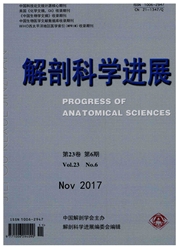

 中文摘要:
中文摘要:
目的观察S1PR2对不同时间点小鼠后肢缺血模型血流恢复情况的影响,探讨其在后肢缺血模型血管新生和血流恢复中的作用。方法采用戊巴比妥麻醉野生型小鼠和S1PR2-/-小鼠,取仰卧位,钝性分离皮肤肌肉等外周组织后,分别结扎小鼠左后肢股动静脉及其分支后缝合,建立小鼠后肢缺血模型。分别于术后第1、3、5、7、10和14天采用激光多普勒血流分析仪观察缺血后肢血流变化情况。于术后第14天处死动物取腓肠肌组织行CD31、NG2免疫荧光染色,计数微脉管密度。结果术后714天,S1PR2-/-小鼠血流恢复情况显著优于野生型小鼠(P〈0.05),且术后第14天,S1PR2-/-小鼠缺血后肢CD31和NG2阳性的微血管密度显著高于野生型小鼠(P〈0.05)。结论敲除S1PR2基因可促进小鼠后肢缺血模型血管新生和血流恢复。
 英文摘要:
英文摘要:
Objective To study the effect of sphingosine-1-phosphate receptor 2(S1PR2) knockout on the angiogenesis and blood flow recovery in mice at different time points. Methods Hindlimb ischemia model was induced in both 8-12 week old male wild-type mice and S1PR2-knockout mice. Mice were subjected to surgical procedures to achieve unilateral hindlimb ischaemia after intraperitoneal injection of pentobarbital. The blood flow was observed at post-operative day1, 3, 5, 7, 10 and 14 by Laser Doppler Blood Flow(LDBF) analyzer. Ischemic tissue of calf muscle was excised at day14 after operation for immunoflorescent staining to detect the microvessel density. Results The blood flow recovery was significantly increased from day7 to day14 after operation in S1PR2 deficient mice compared with wild-type mice( 〈0.05). CD31-positive and NG2-positive microvessel density was significantly increased in S1PR2 deficient mice compared with wild-type mice( 〈 0.05) at post-operative day14. Conclusion The ablation of S1PR2 promoted ischemia-induced angiogenesis and blood flow recovery.
 同期刊论文项目
同期刊论文项目
 同项目期刊论文
同项目期刊论文
 期刊信息
期刊信息
